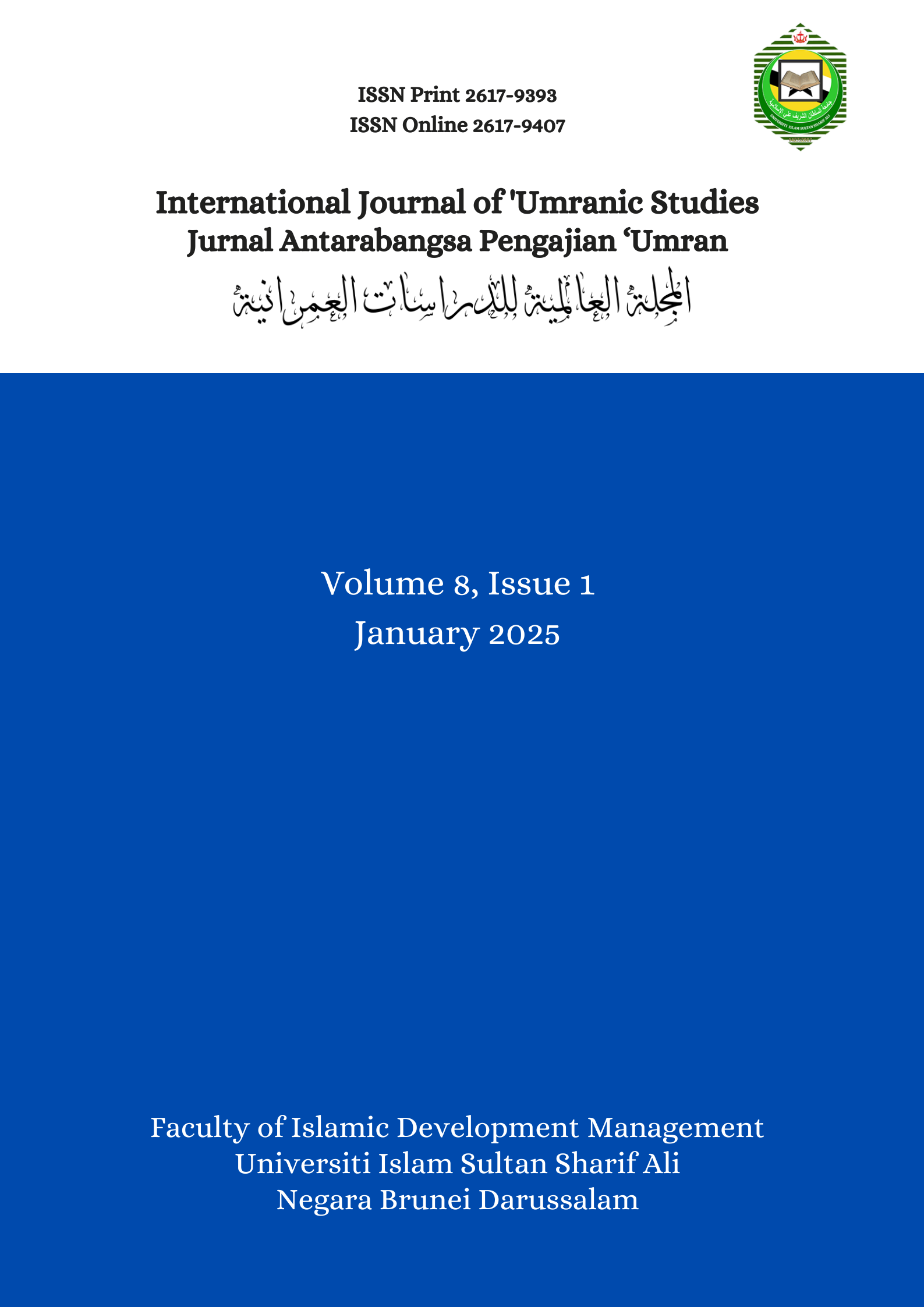EVALUATING THE EFFECTIVENESS OF THE 'SISTEM SUMBER MANUSIA' ONLINE APPLICATION FOR GOVERNMENT EMPLOYEES IN BRUNEI DARUSSALAM
Published 2025-03-25
Keywords
- Sistem Sumber Manusia (SSM),
- Government Sector,
- Employee Satisfaction,
- HR System Effectiveness,
- Digital Transformation
- e-Government,
- Usability Challenges,
- Security Concerns ...More
How to Cite

This work is licensed under a Creative Commons Attribution 4.0 International License.
Copyright NoticeAbstract
Purpose of the Study: This study evaluates the effectiveness of the 'Sistem Sumber Manusia' (SSM) online application in Brunei Darussalam’s government sector, focusing on employee satisfaction, system usability, and its impact on Human Resource (HR) processes. The study aims to identify the benefits, challenges, and potential improvements necessary to optimize the system for government employees.
Methodology: A structured quantitative approach was employed, utilizing literature reviews and surveys distributed among government employees in the Ministry of Education. The study used stratified random sampling to ensure representative participation across different job roles. Data were analyzed through descriptive statistics and thematic analysis to assess employee satisfaction, usability issues, and system effectiveness.
Main Findings: The findings reveal that while the SSM application has improved HR operations by streamlining payroll and administrative tasks, employees face difficulties related to system complexity, data security concerns, and accessibility challenges. The majority of respondents expressed moderate satisfaction with the system, with usability issues being the most frequently cited drawback. Key concerns include difficulties in navigating the system, password expiration issues, and privacy risks.
Application of this Study: This study provides valuable insights for policymakers and HR professionals in optimizing digital HR systems within government institutions. The recommendations, including enhanced user training, security improvements, and system refinements, can aid in improving the adoption and effectiveness of e-Government initiatives in Brunei Darussalam.
Novelty/Originality of this Study: This research is among the first to comprehensively assess the effectiveness of the SSM system within Brunei’s government sector. Unlike previous studies that focus on generic HR information systems, this study highlights context-specific challenges and proposes solutions aligned with the technological capabilities and workforce composition of Brunei.
Significance: The study contributes to the ongoing digital transformation of HR management in government institutions by providing empirical evidence on system effectiveness and user concerns. The recommendations can guide system developers, policymakers, and HR professionals in improving digital HR systems, ensuring greater employee satisfaction and operational efficiency.
References
- Holy Book:
- Al-Quran Al-Karim.
- Books:
- Kavanagh, M. J., & Thite, M. (2021). Human Resource Information Systems: Basics, Applications, and Future Directions (5th ed.). SAGE Publications.
- Nielsen, J. (1994). Usability engineering. Morgan Kaufmann.
- Rubin, J., & Chisnell, D. (2008). Handbook of usability testing: How to plan, design, and conduct effective tests. Wiley.
- Journal Articles:
- Abusamhadana, G. A., Bakon, K. A., & Elias, N. F. (2021). E-government in Ghana: The benefits and challenges. Asia-Pacific Journal of Information Technology and Multimedia, 10(1), 124–140.
- Ahmad, Z., & Omar, Z. (2014). An investigation of the effect of Islamic ethics in human resource management practices among selected Islamic organizations in Malaysia. International Journal of Management Studies, 21(1), 107–123.
- Anupa, M. (2021). Role of human resources information system (HRIS) in accelerating organizational effectiveness–IT companies perspective. International Journal of Management and Humanities (IJMH), 5(6), 22–25.
- Beckmann, M. (2005). Age structure and the adoption of new technologies. ZEW Discussion Paper No. 05-84.
- Bondarouk, T., Parry, E., & Furtmueller, E. (2017). Electronic HRM: Four decades of research on adoption and consequences. The International Journal of Human Resource Management, 28(1), 98–131. https://doi.org/10.1080/09585192.2016.1245672
- Kettinger, W. J., Teng, J. T., & Guha, S. (1997). Business process change: A study of methodologies, techniques, and tools. MIS Quarterly, 21(1), 55–80.
- Lazim, M., Aziz, N., Mahmood, R., & Tosho, A. (2023). User satisfaction on human resources management information system: Implementation in enforcement organization. International Journal of Social Science Research, 11, 31. https://doi.org/10.5296/ijssr.v11i2.20827
- Lee, K., Romzi, P., Hanaysha, J., Alzoubi, H., & Alshurideh, M. (2022). Investigating the impact of benefits and challenges of IoT adoption on supply chain performance and organizational performance: An empirical study in Malaysia. Uncertain Supply Chain Management, 10(2), 537–550.
- Mohapatra, S., Biswas, S. N., & Mohanty, H. (2020). Effective practices for selecting human resource information systems (HRIS). International Journal of Human Resource Management, 31(11), 1371–1393. https://doi.org/10.1080/09585192.2018.1524360
- Rosen, B. (1978). Management perceptions of older employees. Monthly Labor Review, 101(5), 33–35.
- Shet, S., Poddar, T., Fosso Wamba, S., & Dwivedi, Y. (2021). Examining the determinants of successful adoption of data analytics in human resource management: A framework for implications. Journal of Business Research, 131, 311–326. https://doi.org/10.1016/j.jbusres.2021.03.054
- Siddiqui, F. (2016). A study of Islamic ethics and its impact on human resource management practices. International Journal of Management and Applied Science, 2(2), 149–152.
- Smith, J., & Doe, J. (2022). Overcoming challenges in system integration: A comprehensive review. Journal of Systems Integration, 15(2), 112–125.
- Themistocleous, M., Irani, Z., & Love, P. E. (2001). The impact of application integration on organizations: A case study. Journal of Information Technology Management, 22(4), 36–46.
- Venkatesh, V., Morris, M. G., Davis, G. B., & Davis, F. D. (2003). User acceptance of information technology: Toward a unified view. MIS Quarterly, 27(3), 425–478.
- Websites:
- Hammad, F., Wastell, D., & Chesney, T. (2016). Creating inclusive user interfaces: Toward a comprehensive inclusivity evaluation. e-Society 2016, 28. Retrieved from https://www.iadisportal.org/digital-library/creating-inclusive-user-interfaces-toward-a-comprehensive-inclusivity-evaluation
- Samira, H. (2017). Challenges in the implementation of human resource management information system in private firms in Kenya: A case study of Growth from Knowledge Retail and Technology East Africa (pp. 1–72). Retrieved from https://core.ac.uk/download/pdf/157498158.pdf
- Zafar, H., & Stone, D. L. (2017). Human resource information system privacy and security. Retrieved from https://www.researchgate.net/publication/315942872_HRIS_Privacy_and_Security



